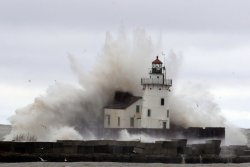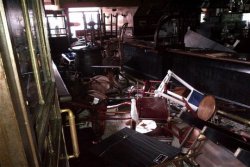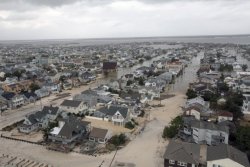

 Click on the images to see the larger pictures
Click on the images to see the larger pictures
Back to previous page
Hurricane Sandy Cause Havoc in America 2012
By Erin McClam and Katie Zezima, The Associated Press | Associated Press - Tue, Oct 30, 2012
NEW YORK, N.Y. - Superstorm Sandy slammed into the New Jersey coastline and hurled a record-breaking four-metre surge of seawater at New York City on Monday, roaring ashore and putting the presidential campaign on hold a week before election day At least 13 deaths were blamed on the storm.
Sandy knocked out power to at least 5.7 million people, and New York's main utility said large sections of Manhattan had been plunged into darkness by the storm, with 250,000 customers without power as water pressed into the island from three sides, flooding rail yards, subway tracks, tunnels and roads.
Just before its centre reached land, the storm was stripped of hurricane status, but the distinction was purely technical, based on its shape and internal temperature. It still packed hurricane-force wind, and forecasters were careful to say it remained every bit as dangerous to the 50 million people in its path. By late night, the centre of the storm was over southern New Jersey.
|



The National Hurricane Center announced at 8 p.m. that Sandy had come ashore near Atlantic City. It smacked the boarded-up big cities of the Northeast corridor, from Washington and Baltimore to Philadelphia, New York and Boston, with stinging rain and gusts of more than 85 135 kilometres per hour. The sea surged a record of nearly four metres at the foot of Manhattan, flooding the financial district and subway tunnels.
The 13 deaths were reported in New Jersey, New York, West Virginia, Pennsylvania and Connecticut. Some of the victims were killed by falling trees. Police in Toronto said a woman was killed by a falling sign as high winds closed in on Canada's largest city.
As it made its way toward land, it converged with a cold-weather system that turned into a fearsome superstorm, a monstrous hybrid consisting not only of rain and high wind but of snow. Forecasters warned of six-metre waves bashing into the Chicago lakefront and up to 90 centimetres of snow in West Virginia.
Storm damage was projected at $10 billion to $20 billion, meaning it could prove to be one of the costliest natural disasters in U.S. history.
|



President Barack Obama and Mitt Romney suspended their campaigning with just over a week to go before election day.
At the White House, Obama made a direct appeal to those in harm's way: "Please listen to what your state and local officials are saying. When they tell you to evacuate, you need to evacuate. Don't delay, don't pause, don't question the instructions that are being given, because this is a powerful storm."
The storm washed away a section of the Atlantic City Boardwalk in New Jersey. Water was splashing over the seawalls at the southern tip of Manhattan.
New York Mayor Michael Bloomberg said late Monday that the worst of the rain had passed for the city, and that the high tide that sent water sloshing into Manhattan from three sides was receding.
Still, authorities also feared the surge of seawater would damage the underground electrical and communications lines in lower Manhattan that are vital to the nation's financial centre.
Water began pooling in rail yards and on highways near the Hudson River waterfront on Manhattan's far west side. On coastal Long Island, floodwaters swamped cars, downed trees and put neighbourhoods under water as beachfronts and fishing villages bore the brunt of the storm. A police car was lost rescuing 14 people from the popular resort Fire Island.
|



In downtown Manhattan, rescue workers floated bright orange rafts on flooded streets, while police officers with loudspeakers told people to go home.
"Now it's really turning into something," said Brian Damianakes, taking shelter in a bank vestibule and watching a trash can blow down the street in Battery Park.
A construction crane atop a luxury high-rise in midtown Manhattan collapsed in high winds and dangled precariously. Residents in surrounding buildings were ordered to move to lower floors and the streets below were cleared, but there were no immediate reports of injuries.
The facade of a four-storey Manhattan building in the Chelsea neighbourhood crumbled and collapsed suddenly, leaving the lights, couches, cabinets and desks inside visible from the street. No one was hurt, although some of the falling debris hit a car.
The major American stock exchanges closed for the day, the first unplanned shutdown since the Sept. 11 attacks in 2001. Wall Street expected to remain closed on Tuesday. The United Nations cancelled all meetings at its New York headquarters.
Not only was the New York subway shut down, but the Holland Tunnel connecting New York to New Jersey was closed, as was a tunnel between Brooklyn and Manhattan. The Brooklyn Bridge, the George Washington Bridge, the Verrazano-Narrows Bridge and several other spans were closed because of high winds.
Authorities had warned that New York City and Long Island could get the worst of the storm surge: a three-metre onslaught of seawater that could swamp Lower Manhattan, flood the subways and damage the underground network of electrical and communications lines that are vital to the nation's financial capital.
"Leave immediately. Conditions are deteriorating very rapidly, and the window for you getting out safely is closing," New York Mayor Michael Bloomberg told those in low-lying areas earlier in the day.
|



Defiant New Yorkers jogged, pushed strollers and took snapshots of churning New York Harbor during the day Monday, trying to salvage normal routines.
Without most stores and museums open, tourists were left to snap photos of the World Trade Center site, Wall Street and Times Square in largely deserted streets.
Belgian tourist Gerd Van don Mooter-Dedecker, 56, wandered in to Trinity Church after learning that a planned shopping spree with her husband Monday wouldn't happen. "We brought empty suitcases so we could fill them up," she said.
|



As rain from the leading edges began to fall over the Northeast on Sunday, hundreds of thousands of people from Maryland to Connecticut were ordered to leave low-lying coastal areas, including 375,000 in lower Manhattan and other parts of New York City, 50,000 in Delaware and 30,000 in Atlantic City, New Jersey.
Obama declared emergencies in Massachusetts, Connecticut, Rhode Island, New York, New Jersey and Pennsylvania, authorizing federal relief work to begin well ahead of time. He promised the government would "respond big and respond fast" after the storm hits.
Off North Carolina, a replica of the 18th-century sailing ship HMS Bounty that was built for the 1962 Marlon Brando movie "Mutiny on the Bounty" went down in the storm, and 14 crew members were rescued by helicopter from rubber lifeboats bobbing in 5.5-metre seas. Another crew member was found hours later and was hospitalized in critical condition. The captain was still missing.
|



|


 Click on the images to see the larger pictures
Click on the images to see the larger pictures




















